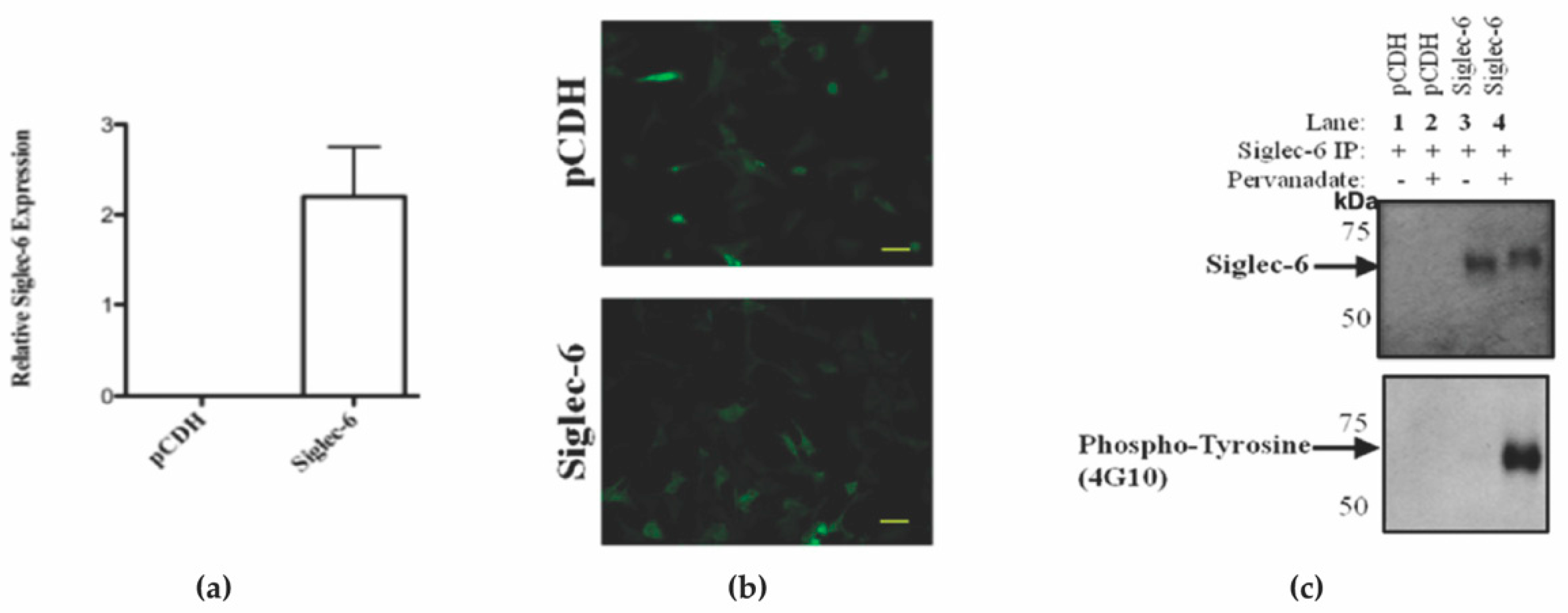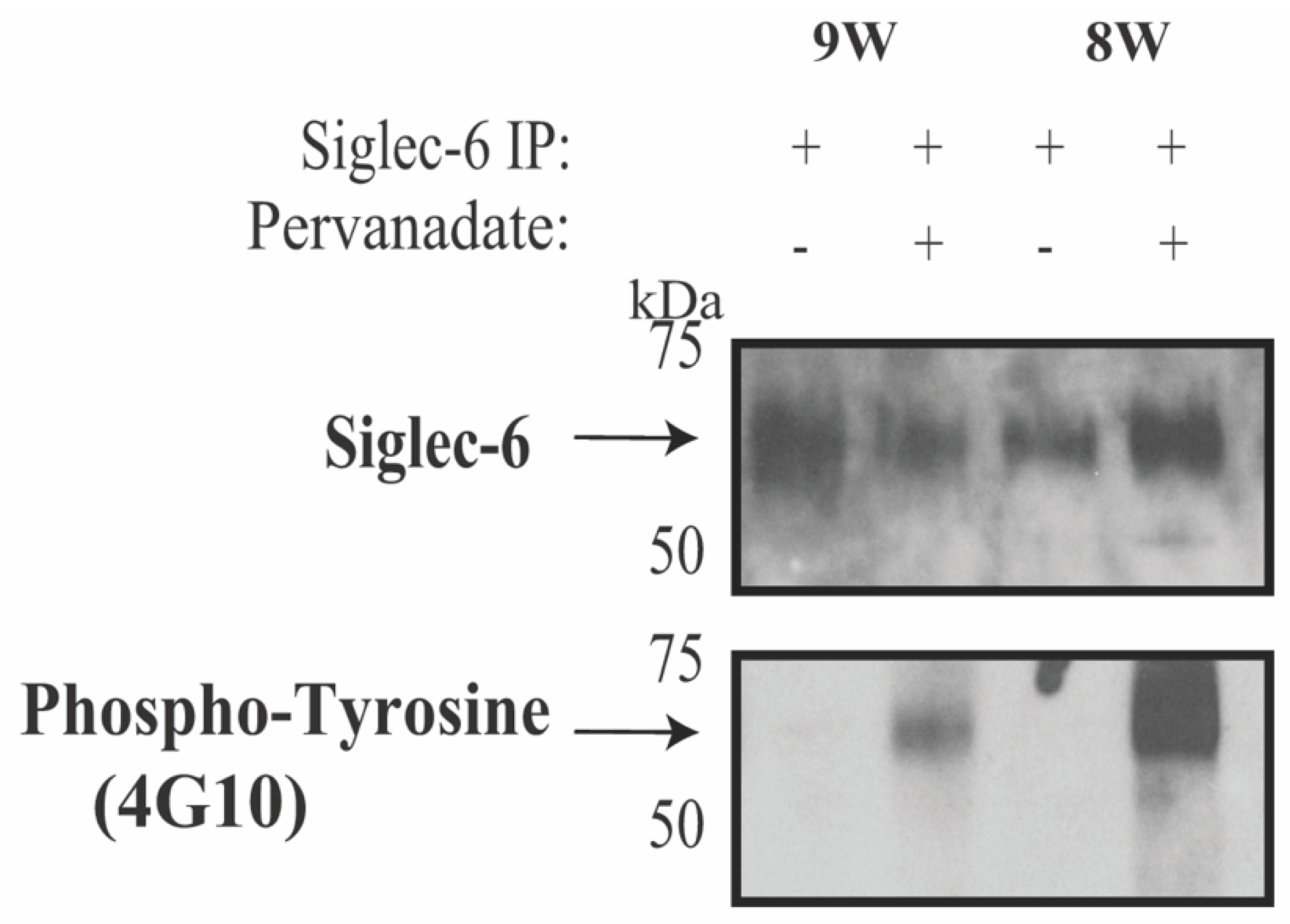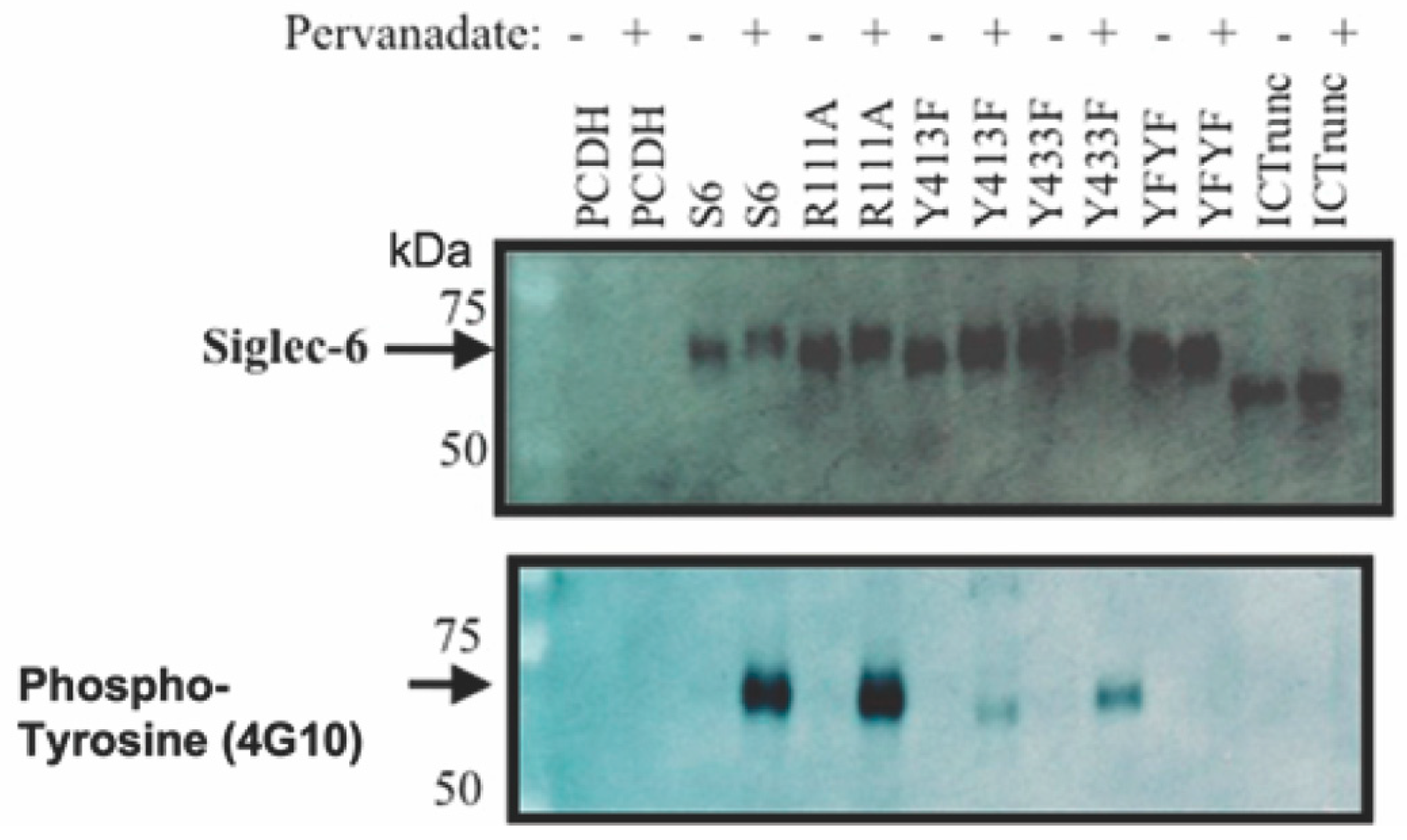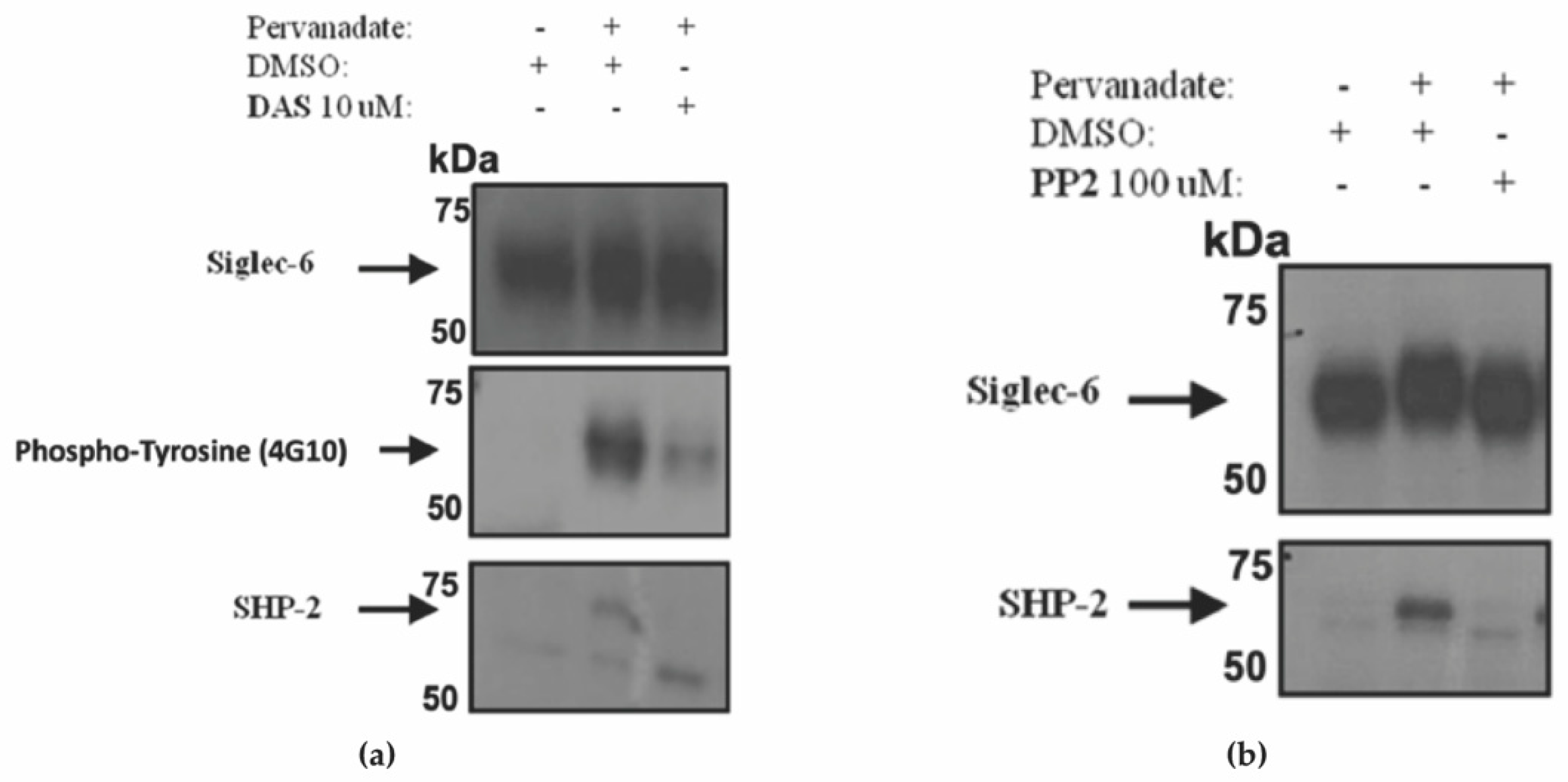Siglec-6 Signaling Uses Src Kinase Tyrosine Phosphorylation and SHP-2 Recruitment
Abstract
1. Introduction
2. Materials and Methods
2.1. Placental Tissue Collection
2.2. Cell Lines
2.3. Expression Plasmids and Site-Directed Mutagenesis
2.4. Generation of Stably Expressing Full-Length and Mutated Siglec-6 HTR-8/SVneo Cell Lines
2.5. Analysis of Tyrosine Phosphorylation of Siglec-6 and Interaction with SHP-1 and SHP-2 in HTR-8/SVneo Cells and Chorionic Villi from First-Trimester Placenta
2.6. Src Kinase Inhibition Studies
3. Results
3.1. pCDH Vector-Mediated Expression of Siglec-6 in HTR-8/SVneo Cells Allows for In Vitro Detection of Siglec-6 Tyrosine Phosphorylation
3.2. Human Placental Siglec-6 Is Tyrosine-Phosphorylated
3.3. Site-Directed Mutations of Siglec-6 Reveal Intracellular ITIM and ITIM-like Tyrosine Phosphorylation
3.4. Dually Tyrosine Phosphorylated Siglec-6 Associates with SHP-2
3.5. Siglec-6 Phosphorylation and Recruitment of SHP-2 Was Prevented by Treatment with Inhibitors of Src-Family Kinases
4. Discussion
Author Contributions
Funding
Institutional Review Board Statement
Informed Consent Statement
Data Availability Statement
Acknowledgments
Conflicts of Interest
References
- Young, B.C.; Levine, R.J.; Karumanchi, S.A. Pathogenesis of preeclampsia. Annu. Rev. Pathol. 2010, 5, 173–192. [Google Scholar] [CrossRef] [PubMed]
- Huppertz, B. Placental origins of preeclampsia: Challenging the current hypothesis. Hypertension 2008, 51, 970–975. [Google Scholar] [CrossRef] [PubMed]
- Winn, V.D.; Gormley, M.; Paquet, A.C.; Kjaer-Sorensen, K.; Kramer, A.; Rumer, K.K.; Haimov-Kochman, R.; Yeh, R.-F.; Overgaard, M.T.; Varki, A.; et al. Severe preeclampsia-related changes in gene expression at the maternal-fetal interface include sialic acid-binding immunoglobulin-like lectin-6 and pappalysin-2. Endocrinology 2009, 150, 452–462. [Google Scholar] [CrossRef] [PubMed]
- Patel, N.; Brinkman-Van der Linden, E.C.; Altmann, S.W.; Gish, K.; Balasubramanian, S.; Timans, J.C.; Peterson, D.; Bell, M.P.; Bazan, J.F.; Varki, A.; et al. OB-BP1/Siglec-6: A leptin- and sialic acid-binding protein of the immunoglobulin superfamily. J. Biol. Chem. 1999, 274, 22729–22738. [Google Scholar] [CrossRef] [PubMed]
- Brinkman-Van der Linden, E.C.M.; Hurtado-Ziola, N.; Hayakawa, T.; Wiggleton, L.; Benirschke, K.; Varki, A.; Varki, N. Human-specific expression of Siglec-6 in the placenta. Glycobiology 2007, 17, 922–931. [Google Scholar] [CrossRef]
- Benirschke, K.; Kaufmann, P.; Baergen, R.N. Pathology of the Human Placenta, 5th ed.; Springer: New York, NY, USA, 2006. [Google Scholar]
- Rumer, K.K.; Uyenishi, J.; Hoffman, M.C.; Fisher, B.M.; Winn, V.D. Siglec-6 expression is increased in placentas from pregnancies complicated by preterm preeclampsia. Reprod. Sci. 2013, 20, 646–653. [Google Scholar] [CrossRef] [PubMed]
- Rumer, K.K.; Post, M.D.; Larivee, R.S.; Zink, M.; Uyenishi, J.; Kramer, A.; Teoh, D.; Bogart, K.; Winn, V.D. Siglec-6 is expressed in gestational trophoblastic disease and affects proliferation, apoptosis, and invasion. Endocr.-Relat. Cancer 2012, 19, 827–840. [Google Scholar] [CrossRef] [PubMed]
- Crocker, P.R.; Paulson, J.C.; Varki, A. Siglecs and their roles in the immune system. Nat. Rev. Immunol. 2007, 7, 255–266. [Google Scholar] [CrossRef] [PubMed]
- Varki, A. Essentials of Glycobiology, 2nd ed.; Cold Spring Harbor Laboratory Press: New York, NY, USA, 2009. [Google Scholar]
- O’Shea, J.J.; McVicar, D.W.; Bailey, T.L.; Burns, C.; Smyth, M.J. Activation of human peripheral blood T lymphocytes by pharmacological induction of protein-tyrosine phosphorylation. Proc. Natl. Acad. Sci. USA 1992, 89, 10306–10310. [Google Scholar] [CrossRef] [PubMed]
- Graham, C.H.; Hawley, T.S.; Hawley, R.G.; MacDougall, J.R.; Kerbel, R.S.; Khoo, N.; Lala, P.K. Establishment and characterization of first trimester human trophoblast cells with extended lifespan. Exp. Cell Res. 1993, 206, 204–211. [Google Scholar] [CrossRef] [PubMed]
- Schneider, U.; Schwenk, H.-U.; Bornkamm, G. Characterization of ebv-genome negative null and t cell lines derived from children with acute lymphoblastic leukemia and leukemic transformed non-hodgkin lymphoma. Int. J. Cancer 1977, 19, 621–626. [Google Scholar] [CrossRef]
- Walter, R.B.; Raden, B.W.; Zeng, R.; Häusermann, P.; Bernstein, I.D.; Cooper, J.A. ITIM-dependent endocytosis of CD33-related Siglecs: Role of intracellular domain, tyrosine phosphorylation, and the tyrosine phosphatases, Shp1 and Shp2. J. Leukoc. Biol. 2008, 83, 200–211. [Google Scholar] [CrossRef] [PubMed]
- Fitzgerald, J.S.; Busch, S.; Wengenmayer, T.; Foerster, K.; de la Motte, T.; Poehlmann, T.G.; Markert, U.R. Signal transduction in trophoblast invasion. Chem. Immunol. Allergy 2005, 88, 181–199. [Google Scholar] [PubMed]
- Nadeau, V.; Charron, J. Essential role of the ERK/MAPK pathway in blood-placental barrier formation. Development 2014, 141, 2825–2837. [Google Scholar] [CrossRef] [PubMed]
- Zhu, R.; Huang, Y.-H.; Tao, Y.; Wang, S.-C.; Sun, C.; Piao, H.-L.; Wang, X.-Q.; Du, M.-R.; Li, D.-J. Hyaluronan up-regulates growth and invasion of trophoblasts in an autocrine manner via PI3K/AKT and MAPK/ERK1/2 pathways in early human pregnancy. Placenta 2013, 34, 784–791. [Google Scholar] [CrossRef] [PubMed]
- Yang, W.; Klaman, L.D.; Chen, B.; Araki, T.; Harada, H.; Thomas, S.M.; George, E.L.; Neel, B.G. An Shp2/SFK/Ras/Erk signaling pathway controls trophoblast stem cell survival. Dev. Cell 2006, 10, 317–327. [Google Scholar] [CrossRef] [PubMed]
- Forbes, K.; Skinner, L.; Aplin, J.D.; Westwood, M. The tyrosine phosphatase SHP-1 negatively regulates cytotrophoblast proliferation in first-trimester human placenta by modulating EGFR activation. Cell. Mol. Life Sci. 2012, 69, 4029–4040. [Google Scholar] [CrossRef] [PubMed]
- Forbes, K.; West, G.; Garside, R.; Aplin, J.D.; Westwood, M. The protein-tyrosine phosphatase, SRC homology-2 domain containing protein tyrosine phosphatase-2, is a crucial mediator of exogenous insulin-like growth factor signaling to human trophoblast. Endocrinology 2009, 150, 4744–4754. [Google Scholar] [CrossRef] [PubMed]
- Huang, Y.; Wang, J.; Cao, F.; Jiang, H.; Li, A.; Li, J.; Qiu, L.; Shen, H.; Chang, W.; Zhou, C.; et al. SHP2 associates with nuclear localization of STAT3: Significance in progression and prognosis of colorectal cancer. Sci. Rep. 2017, 7, 17597. [Google Scholar] [CrossRef] [PubMed]
- Chong, Z.Z.; Maiese, K. The Src homology 2 domain tyrosine phosphatases SHP-1 and SHP-2: Diversified control of cell growth, inflammation, and injury. Histol. Histopathol. 2007, 22, 1251–1267. [Google Scholar] [PubMed]
- Corvinus, F.M.; Fitzgerald, J.S.; Friedrich, K.; Markert, U.R. Evidence for a correlation between trophoblast invasiveness and STAT3 activity. Am. J. Reprod. Immunol. 2003, 50, 316–321. [Google Scholar] [CrossRef] [PubMed]
- Borg, A.J.; Yong, H.E.; Lappas, M.; Degrelle, S.A.; Keogh, R.J.; Da Silva-Costa, F.; Fournier, T.; Abumaree, M.; Keelan, J.A.; Kalionis, B.; et al. Decreased STAT3 in human idiopathic fetal growth restriction contributes to trophoblast dysfunction. Reproduction 2015, 149, 523–532. [Google Scholar] [CrossRef] [PubMed]
- Zhang, S.Q.; Yang, W.; Kontaridis, M.I.; Bivona, T.G.; Wen, G.; Araki, T.; Luo, J.; Thompson, J.A.; Schraven, B.L.; Philips, M.R.; et al. Shp2 regulates SRC family kinase activity and Ras/Erk activation by controlling Csk recruitment. Mol. Cell 2004, 13, 341–355. [Google Scholar] [CrossRef]
- McMillan, S.J.; Crocker, P.R. CD33-related sialic-acid-binding immunoglobulin-like lectins in health and disease. Carbohydr. Res. 2008, 343, 2050–2056. [Google Scholar] [CrossRef] [PubMed]






| Name | Sequence |
|---|---|
| R111A Forward | 5′-GACAATGCTGCATACTTCTTTGCCTTGAAGTCCAAATGGATG-3′ |
| R111A Reverse | 5′-CATCCATTTGGACTTCAAGGCAAGAA GTA TGC AGC ATT GTC-3′ |
| Y413F Forward | 5′-GAAGATGAGCAGGAGCTCCACTTCGCTGTCCTACACTTCCACAAG-3′ |
| Y413F Reverse | 5′-CTTGTGGAAGTGTAGGACAGCGAAGTG GAGCTCCTGCTCATCTTC-3′ |
| Y433F Forward | 5′-CCAAAG GTCACCGACACTGAGTTCTCAGAAATCAAGATACACAAG-3′ |
| Y433F Reverse | 5′-CTTGTGTATCTTGATTTCTGAGAACTCAGTGTCGGTGACCTT TGG-3′ |
| ICtrunc Forward | 5′-CAGTTCCAGACAGGCATAGTTTGAGACCACCCTGCTGAGGCTGGC-3′ |
| ICtrunc Reverse | 5′-GCCAGCCTCAGCAGGGTGGTCTCAAACTATGCCTGTCTGGAACTG-3′ |
| Name | Sequence |
|---|---|
| CMV Forward | 5′-CACGCTGTTTTGACCTCCATAGA-3′ |
| Siglec-6 Forward | 5′-GGAGAGAACATGGTACCTCTCAGT-3′ |
| Siglec-6 Mid Forward | 5′-GCTGCCCCCCACCTCCTGGGCCCC-3′ |
| Siglec-6 Reverse | 5′-AAGACACAAGGAGGAGACAGCCAT-3′ |
Publisher’s Note: MDPI stays neutral with regard to jurisdictional claims in published maps and institutional affiliations. |
© 2022 by the authors. Licensee MDPI, Basel, Switzerland. This article is an open access article distributed under the terms and conditions of the Creative Commons Attribution (CC BY) license (https://creativecommons.org/licenses/by/4.0/).
Share and Cite
Stefanski, A.L.; Renecle, M.D.; Kramer, A.; Sehgal, S.; Narasimhan, P.; Rumer, K.K.; Winn, V.D. Siglec-6 Signaling Uses Src Kinase Tyrosine Phosphorylation and SHP-2 Recruitment. Cells 2022, 11, 3427. https://doi.org/10.3390/cells11213427
Stefanski AL, Renecle MD, Kramer A, Sehgal S, Narasimhan P, Rumer KK, Winn VD. Siglec-6 Signaling Uses Src Kinase Tyrosine Phosphorylation and SHP-2 Recruitment. Cells. 2022; 11(21):3427. https://doi.org/10.3390/cells11213427
Chicago/Turabian StyleStefanski, Adrianne L., Michael D. Renecle, Anita Kramer, Shilpi Sehgal, Purnima Narasimhan, Kristen K. Rumer, and Virginia D Winn. 2022. "Siglec-6 Signaling Uses Src Kinase Tyrosine Phosphorylation and SHP-2 Recruitment" Cells 11, no. 21: 3427. https://doi.org/10.3390/cells11213427
APA StyleStefanski, A. L., Renecle, M. D., Kramer, A., Sehgal, S., Narasimhan, P., Rumer, K. K., & Winn, V. D. (2022). Siglec-6 Signaling Uses Src Kinase Tyrosine Phosphorylation and SHP-2 Recruitment. Cells, 11(21), 3427. https://doi.org/10.3390/cells11213427









